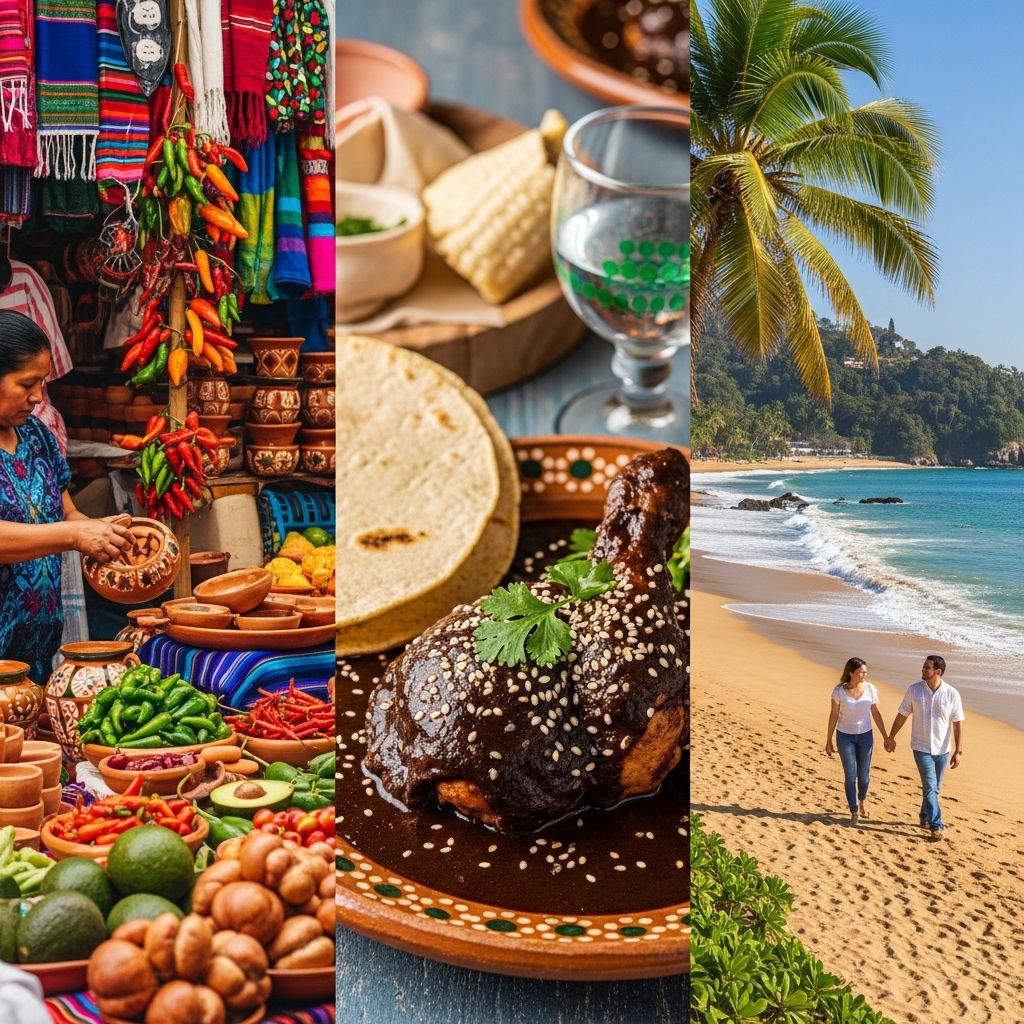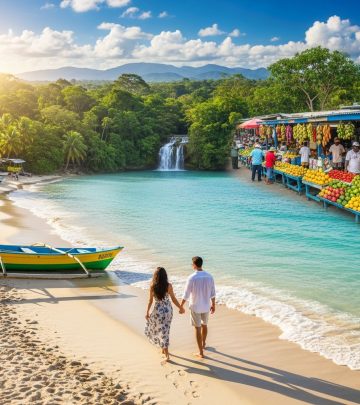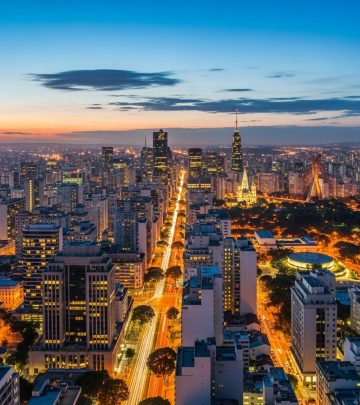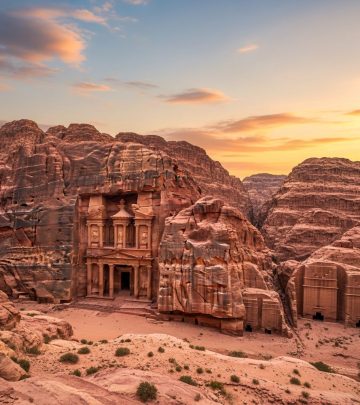Oaxaca State: Where Culture, Cuisine, and Coastlines Captivate
Experience Oaxaca State’s vibrant heritage, remarkable food, and diverse natural wonders for an unforgettable Mexican adventure.

Discover Oaxaca State: A Cultural and Natural Treasure
Oaxaca State, nestled in southern Mexico, stands as a beacon for travelers seeking authentic immersion. With its blend of indigenous Zapotec and Mixtec traditions, colonial landmarks, culinary excellence, and sun-soaked Pacific shores, Oaxaca’s riches appeal to history buffs, adventure seekers, and food-lovers alike.
Travelers are drawn to discover:
- World-class festivals, such as Día de Muertos and Guelaguetza
- Indigenous crafts and artisan villages
- Spectacular ruins, like Monte Albán and Mitla
- Renowned Oaxacan cuisine and mezcal
- Breathtaking beaches and mountain getaways
Overview: What Makes Oaxaca Unique?
Oaxaca distinguishes itself among Mexican destinations through its deep-rooted indigenous identity, centuries-old artistic heritage, and dramatic natural beauty. The capital, Oaxaca City, is recognized as a UNESCO World Heritage Site and remains central to the state’s allure.
How Long Should You Spend in Oaxaca State?
Oaxaca State is best experienced at a relaxed pace, offering layers of history, culture, and landscape beyond the capital’s cobbled streets. Your ideal itinerary could look like:
- 1–2 Days: Focus on the cultural heart, Oaxaca City. Indulge in local markets, sample world-famous cuisine, and visit essential museums and art scenes.
- 5 Days: Venture into the valleys—explore ancient Zapotec ruins (Mitla, Monte Albán), soak in the mineral springs of Hierve El Agua, taste mezcal in Santiago Matatlán, and hike the Sierra Norte mountains.
- 1+ Week: Head for the coast! Experience Puerto Escondido’s surf culture, unwind in the pristine Bahías de Huatulco, and enjoy the laid-back vibes of Mazunte and Zipolite. For true escape, find the lagoons and wildlife of Parque Nacional Lagunas de Chacahua.
Sample Itinerary Table
| Duration | Highlights |
|---|---|
| 1–2 Days | Oaxaca City: Museums, colonial plazas, markets, cuisine |
| 5 Days | Monte Albán, Mitla, Valle hiking, mezcal tasting, Hierve El Agua |
| 7+ Days | Pacific Coast: Puerto Escondido, Mazunte, Zipolite, Huatulco |
Oaxaca City: The Cultural Capital
Oaxaca City combines colonial charm with vibrant indigenous life—majestic churches, lively markets, and open-air plazas set the stage for street art, artisan workshops, and mezcal bars. Walk the tranquil lanes, encountering local color at every turn.
- Museo de las Culturas de Oaxaca: Dive deep into archaeological finds and regional history.
- Artisan markets: See woven textiles, black clay pottery, and alebrije creatures.
- Satirical street art: Oaxaca is known for its political murals reflecting local activism and creative energy.
- Mezcalerías: Sample local mezcal, often produced by family-run distilleries.
Santo Domingo: Baroque Marvel & Botanical Oasis
No visit to Oaxaca City is complete without marveling at the Templo de Santo Domingo de Guzmán. This Mexican Baroque masterpiece serves as the city’s spiritual and architectural centerpiece.
- Declared a historical monument in 1933.
- Features ornate altarpieces, frescoes, and the genealogical tree of Saint Dominic.
- Hosts major events, including Oaxacan calendas (parades), weddings, and TV productions.
- Jardín Etnobotánico de Oaxaca: An exceptional botanical garden showcasing endemic flora. Can only be visited via guided tours in Spanish and English.
Local Tip:
The Jardín Etnobotánico is open year-round with guided tours. Advance booking is recommended.
Feasts for the Senses: What to Eat in Oaxaca
Oaxaca’s food scene is legendary, offering a spectrum from bustling market snacks to Michelin-acclaimed dining.
- Tlayudas: Crispy, oversized tortillas topped with beans, cheese, pork fat (asiento), or tasajo (beef).
- Quesillo: Oaxaca’s string cheese—soft, mild, and a market favorite.
- Chapulines: Toasted crickets—nutty, crunchy, and boldly Oaxacan.
- Pasillo de Humo: A smoky market corridor brimming with grilled meats—cecina enchilada, chorizo oaxaqueño, longaniza, ribs, tripe. Enjoy with fresh salsa.
- Boulenc/Pan con Madre: Renowned bakeries for breakfast pastries and coffee.
- Tierra del Sol: Michelin Bib Gourmand restaurant where Chef Olga Cabrera presents Mixtec recipes on a rooftop patio.
Local Tip:
For popular restaurants, reserve ahead. For deeper insight, join a cooking class with a traditional Oaxacan chef.
Traditional Festivals & Cultural Experiences
- Día de Muertos (Day of the Dead): Oaxaca’s Día de Muertos celebrations (Nov 1–2) are among Mexico’s grandest, with costumed parades, sand art, and candlelit vigils.
- Guelaguetza Festival: Held in July, Oaxaca’s folkloric dance and music festival is an unmissable spectacle of indigenous pride. Book accommodations months ahead, as availability quickly fills up.
Local Life: Indigenous Villages and Artisan Towns
Beyond the capital, the valleys of Oaxaca reveal living traditions in Zapotec, Mixtec, and Mazatec towns.
- Teotitlán del Valle: Famed for handwoven textiles and natural dyes.
- Santiago Matatlán: The “world capital of mezcal,” dotted with artisanal distilleries (palenques).
- Pueblos Mancomunados: Eight Zapotec villages united for sustainable ecotourism—ideal for hiking, biking, and immersive homestays.
Natural Wonders: Ruins, Springs, and Wilderness
- Monte Albán: Zapotec capital and UNESCO site, perched above Oaxaca City.
- Mitla: Sacred city known for exquisite stone mosaics.
- Hierve El Agua: Cliff-top mineral springs and “petrified waterfalls.” Ideal for hiking and swimming.
- El Tule: Visit the world’s widest tree—an ancient Montezuma cypress.
Pacific Coast Paradises
Oaxaca’s Pacific coastline offers diverse beach experiences:
- Puerto Escondido: Legendary surf breaks, lively beach culture, and vibrant nightlife.
- Bahías de Huatulco: Protected bays with hidden beaches and abundant sea life.
- Mazunte/Zipolite: Relaxed, counterculture enclaves ideal for yoga, wellness, and alternative stargazing.
- Lagunas de Chacahua: National park lagoons teeming with wildlife—spectacular for kayaking and nature lovers.
Local Tip:
Many coastal areas can be reached via short flights or scenic drives from Oaxaca City. Explore local transport options for convenience.
Before You Go: Essential Planning Tips
- Advance Booking: Reserve accommodations well ahead for major festivals and high seasons.
- Safety: Oaxaca is considered safe for tourists, with low levels of violent crime. Take standard precautions: avoid excessive displays of wealth, stick to well-lit streets at night, and consult local advice for remote areas.
- Packing: Oaxaca’s weather varies from temperate highlands to humid coasts. Bring layers, sturdy shoes for ruins/hiking, and sun protection.
- Etiquette: Respect local customs, bargain respectfully in markets, and participate mindfully in indigenous ceremonies.
FAQs About Traveling in Oaxaca State
Q: What is the best time to visit Oaxaca State?
A: The months of July (Guelaguetza Festival) and November (Day of the Dead) are peak festival moments. October to May offers mild weather ideal for exploring ruins and beaches.
Q: Is Oaxaca safe for tourists?
A: Yes. Despite Mexico’s reputation for sporadic violence, Oaxaca State is regarded as safe for visitors, including Oaxaca City and major tourist regions. Practice common-sense travel precautions.
Q: Do I need to speak Spanish?
A: Spanish is useful but not essential. Many hotels, guides, and leading restaurants speak English. Consider learning basic greetings and market vocabulary.
Q: Where should I go for the best traditional crafts?
A: Visit artisan villages like Teotitlán del Valle for textiles, San Bartolo Coyotepec for black clay pottery, and Arrazola for vibrant alebrijes.
Q: Can I visit mezcal distilleries?
A: Absolutely. Santiago Matatlán and nearby villages offer tours and tastings at family-run palenques. Take a guided day trip or self-drive through agave fields.
Expert Tips for an Unforgettable Oaxaca Journey
- Walk the historic center: Oaxaca City is best explored on foot—discover quiet courtyards, bohemian bars, and lively squares at your own pace.
- Join a market food tour: Tasting local street food grants a window into daily life and culinary tradition.
- Try a cooking class: Dive into Oaxacan recipes with expert cooks for a hands-on cultural experience.
- Respect traditional ceremonies: Many indigenous communities welcome tourists but expect respectful participation in rituals and festivities.
- Supporting artisans: Buying direct from craftspeople sustains both local culture and livelihoods.
Final Thoughts
Oaxaca State’s captivating blend of history, food, tradition, and landscape guarantees a travel experience unlike any other in Mexico. Whether you stroll among colonial facades, feast in vibrant markets, hike epic ruins, or unwind on wild beaches, Oaxaca’s soul stays with you long after your visit.












